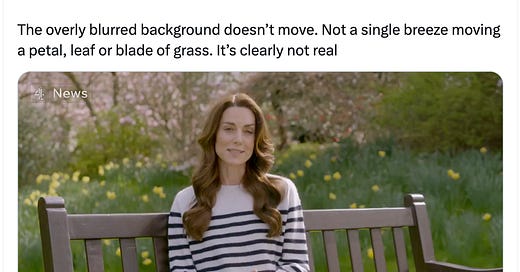AI Anxiety
While I was on vacation last week, I read an article about “AI Doomsayers” and their counterparts, effective accelerationists. These Berkeley nerds have vegan dinner parties wherein they contemplate the end of humanity via artificial intelligence.
The journalist, Andrew Marantz, gives this example to illustrate their anxiety:
“Now imagine a world in which more powerful A.I.s pilot actual boats—and cars, and military drones—or where a quant trader can instruct a proprietary A.I. to come up with some creative ways to increase the value of her stock portfolio. Maybe the A.I. will infer that the best way to juice the market is to disable the Eastern Seaboard’s power grid, or to goad North Korea into a world war. Even if the trader tries to specify the right reward functions (Don’t break any laws; make sure no one gets hurt), she can always make mistakes.”
I read that and scoffed. I don’t think they’re wrong, but I also don’t think we need to reach that deeply into our imaginations to see all the ways AI is making the world and the Internet shittier and less safe. I’ve had fun playing with ChatGPT (see: the illustrations in my banner image), but the speed at which AI images are getting more believable is unsettling. Scam phone calls, fake product reviews, revenge porn, etc. are nothing new, but I can say with certainty that it’s going to get more difficult to suss out what’s real and what’s generated by AI.
When I was 8 years old, I tearfully told my mom and older sisters about Bonsai Kittens, a website that had instructions for how to raise a kitten in a jar so that its bones form to the shape of the container. I was too young and naive to realize this was a hoax, and I’ll never forget my mom gently saying, “But, Rachel, where would they poop?” as I insisted these cats were real. When my kids reach Internet surfing age, I can only hope the Internet hoaxes they believe are as obviously fake as Bonsai Kittens, but I worry that they’ll be far more sophisticated, much less an obvious joke that’s just reached the wrong audience.
I’ve been thinking about this a lot as conspiracy theories have run wild regarding the whereabouts of Kate Middleton. In January, the Palace announced that Princess Catherine would take a break from public appearances to recover from an abdominal surgery. After several weeks of absence, TikTok sleuths speculated that she had been “disappeared” by The Firm, that she had plastic surgery or a domestic violence injury that had temporarily disfigured her, that Prince William had fathered a love child with Rose Hanbury and was planning a divorce, etc. I saw one Twitter user claiming that no abdominal surgery could take this long to recover from, which seems, ironically, to belie a complete lack of imagination. The Palace released an inexpertly photoshopped “proof of life” photo, only adding more grist to the rumor mill, as Internet users wondered whether the image was AI-generated.
Finally, last week, Kensington Palace released a video in which Kate announced that she had been diagnosed with cancer and would be starting chemotherapy and that she had taken the time to heal from her surgery and explain the news to her children. This statement did little to convince some amateur detectives, who speculated that the video itself is AI-generated.
My point isn’t that we should or shouldn’t trust what the Palace is saying in this specific instance, but rather that the prevalence of AI is making credible stories—like a public figure having a health crisis and needing time to recover in private—completely unbelievable, while completely fabricated stories get a pass.
As the Internet gets more and more unbelievable, I find myself increasingly reaching for real things. I want to read books, not articles on my phone. I want to listen to CDs, not Spotify. I want to see my friends in real life rather than text them. I want to shop in person instead of online. I sometimes worry about a future where even this isn’t enough to know whether or not something is AI-generated, but in the meantime, maybe this is how I’ll teach my kids to suss out what’s real. Can you hold it in your hand? Can you feel it?





